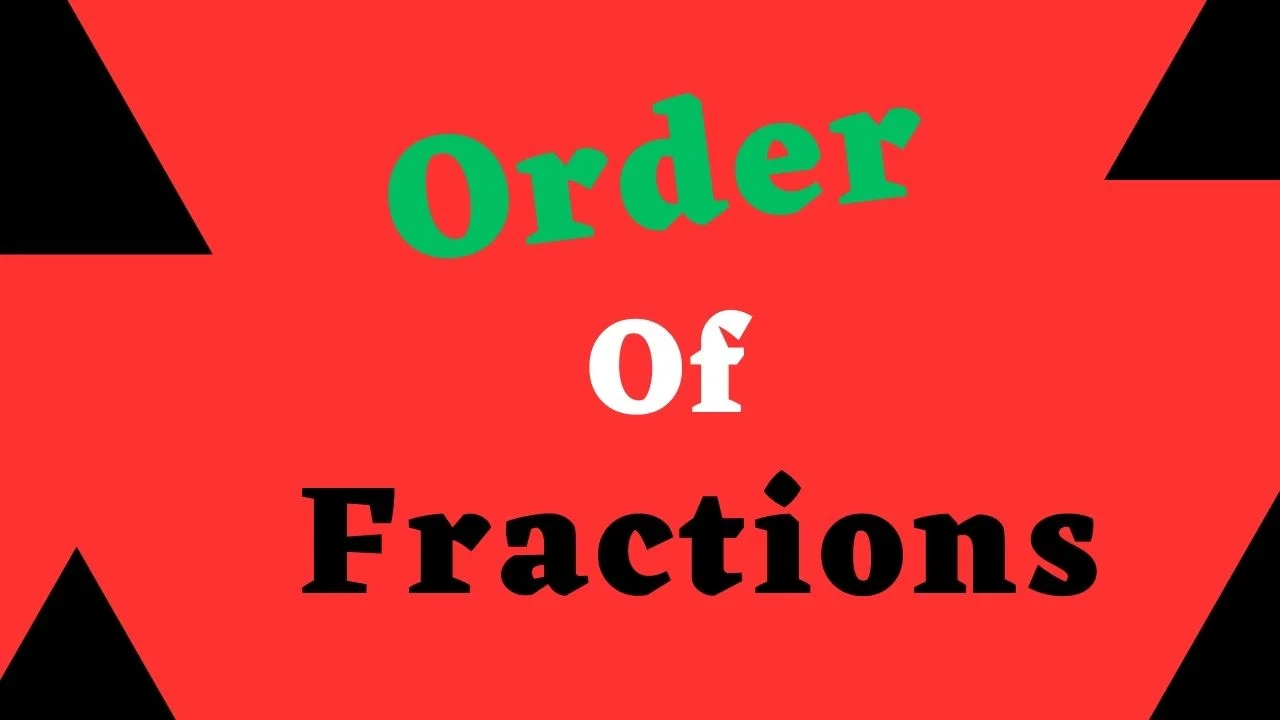We know very well about “fractions”, the value in the form of “p/q” is called a fraction. There are many types of fractions in mathematics i.e. proper fractions, improper fractions, and mixed fractions, like a fraction, unlike fractions, and equivalent fractions, etc.
The “Flemish pamphlet De Thiende”, printed in Leyden in 1585, is credited with popularizing decimal fractions as a calculating tool. In this article, we’ll discuss fractions and how to order fractions with the help of solved examples.
Table of Contents
What is a Fraction?
A fraction is defined as p / q.
Example:
1/2, 3/7, and 5/11 are examples of fractions, etc.
Advantages of fraction:
There are the following advantages of fractions in our daily life:
- It is easy to implement
- It is highly “effective” and “efficient”
- One of the best is that it is easy to use.
Oder of Fractions:
There are the following methods of arranging values, fractions, and numbers. Normally there are two methods of arranging fractions or numbers.
- Ascending order
- Descending Order
Ascending order:
The method of arranging values in which small values are first and greatest value after the small is called ascending order of values.
Descending order:
The method of arranging values in which large values are the first and small values after the large is called the descending order of values.
How to write percentages in the fractional form?
We can write percentage value as a fraction by dividing 100 i.e. 40% can be written in fraction form as 40/100. We easily understand the idea of ordering fractions by doing this conversion on the percentage values.
Methods of ordering fractions:
We already discuss types of arranging values now we describe the method of arranging fractions, normally two basic methods of arranging fractions can be used following.
- Making like fraction
- Conversion method
Making like fractions:
There is the following step for making like fractions.
- Write the fraction
- Write denominators separately
- Find the LCM of all denominators of fractions
- Now make all denominators equal
- After making an equal denominator arrange nominators in the order you want.
Conversion method of fraction:
There are the following steps of the conversion method.
- Write the fraction
- Write each fraction into a percentage by multiplying 100
- Arrange the number by desired order.
How to order fractions?
Here are a few examples to understand how to order fractions.
Example 1:
Using the making-like fraction method arrange the following.
12/5, 13/7, 2/9, 1/17, 21/4, 16/3
Solution:
Step 1: Write the fraction
12/5, 13/7, 2/9, 1/17, 21/4, 16/3
Step 2: Separately Write denominators
Denominators separately = 5, 7, 9, 17, 4, 3
Step 3: Find the LCM of all denominators
LCM = 21420
Step 4: Now make all denominators equal
12 / 5 = ( 12 × 4284 ) / ( 5 × 4284 ) = 51408 / 21420
13 / 7 = ( 13 × 3060 ) / ( 7 × 3060 ) = 39780 / 21420
2 / 9 = ( 2 × 2380 ) / ( 9 × 2380 ) = 4760 / 21420
1 / 17 = ( 1 × 1260 ) / ( 17 × 1260 ) = 1260 / 21420
21 / 4 = ( 21 × 5355 ) / ( 4 × 5355 ) = 112455 / 21420
16 / 3 = ( 16 × 7140 ) / ( 3 × 7140 ) = 114240 / 21420
Step 5: Arrange nominators in the order you want
Ascending order = 1260 / 21420, 4760 / 21420, 39780 / 21420, 51408 / 21420, 112455 / 21420, 114240 / 21420
“The corresponding terms of the above terms are”:
Least to greatest = 1 / 17, 2 / 9, 13 / 7, 12 / 5, 21 / 4, 16 / 3
Descending order = 114240 / 21420, 112455 / 21420, 51408 / 21420, 39780 / 21420, 4760 / 21420, 1260 / 21420
“The corresponding terms of the above terms are”:
Greatest to least = 16 / 3, 21 / 4, 12 / 5, 13 / 7, 2 / 9, 1 / 17
An ordering fractions calculator is a helpful way to order the fractions in ascending order and descending order to avoid time consuming calculations.
Example 2:
Arrange into ascending and descending order the following by using the conversion method:
7 / 13, 9 / 4, 5 / 12, 2 / 9, 16 / 3, 1 / 14
Solution:
Step 1: Write the fraction
7 / 13, 9 / 4, 5 / 12, 2 / 9, 16 / 3, 1 / 14
Step 2: Write the fraction into a percentage by multiplying 100
7 / 13 = (7 × 100) / 13 = 53.8 %
9 / 4 = (9 × 100) / 4 = 225 %
5 / 12 = (5 × 100) / 12 = 41.6 %
2 / 9 = (2 × 100) / 9 = 22.2 %
16 / 3 = (16 × 100) / 3 = 533.3 %
1 / 14 = (1 × 100) / 14 = 7.1 %
Step 3: Arrange the number by desired order
Ascending order = 7.1 %, 22.2 %, 41.6 %, 53.8 %, 225 %, 533.3 %
“The corresponding terms of the above terms are”:
Least to greatest = 1 / 14, 2 / 9, 5 / 12, 7 / 13, 9 / 4, 16 / 3
Descending order = 533.3 %, 225 %, 53.8 %, 41.6 %, 22.2 %, 7.1 %
“The corresponding terms of the above terms are”:
Greatest to least = 16 / 3, 9 / 4, 7 / 13, 5 / 12, 2 / 9, 1 / 14
Final words
In this article, we’ve discussed the order of fractions methods with examples and steps. What is a fraction how many types of fraction, we also discussed the Advantages of a fraction in our daily life? The procedure of finding the order of fractions i.e. making-like fraction method and conversion method.
If you really liked this article, please share it with those who need it.
Thank you.








